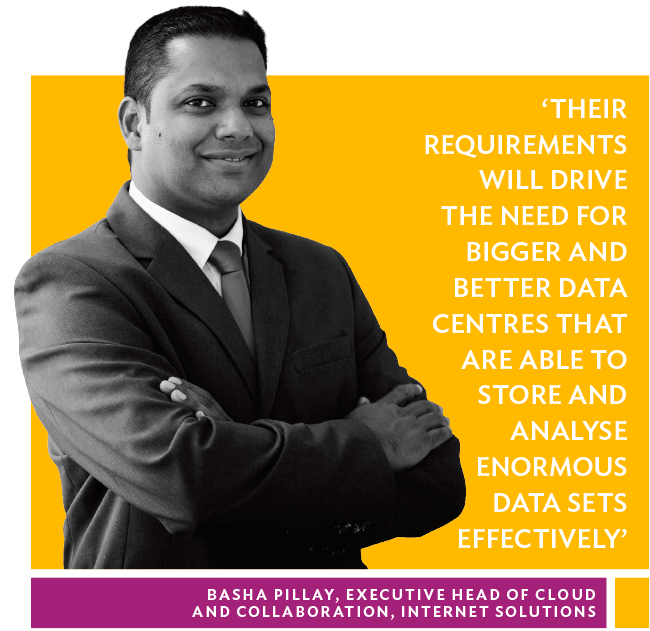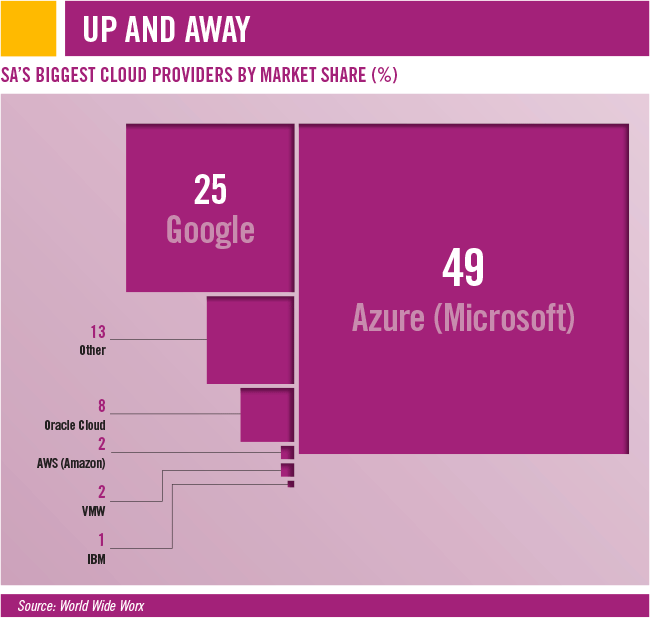Between global giants such as Huawei, Microsoft and Amazon, and local players that include Teraco, Neotel and Liquid Telecom, new data centres are opening up across SA all the time, bringing vastly expanded storage capacity to businesses big and small. It’s certainly no longer a question of when or if SA enterprises will embrace the worldwide move to the cloud. Now it’s a matter of how and why.
‘Over the five years since World Wide Worx conducted equivalent research, use of the cloud among medium and large organisations has more than doubled from less than 50% using it in 2013 to pervasive use in 2018,’ according to World Wide Worx MD Arthur Goldstuck. In the company’s 2018 Cloud Africa Report, 68% of SA companies surveyed cite time-to-market or speed of deployment as the most prominent benefits of cloud adoption.
In the hyper-competitive, tech-driven business environment, it’s little wonder SA businesses are so focused on speed. ‘Speed and accuracy deliver a win-win for both business and its customers,’ according to Dana Buys, CEO of Cape Town-based CloudOne.mobi. ‘Happy customers spend more and spread the good news via word of mouth. Accurate orders reduce costly mistakes and improve profitability. It’s hard to beat if you can make the solution easy to use and affordable to own. There is massive opportunity to deploy affordable cloud and mobile technology in sub-Saharan Africa.’
Recent months have seen a sudden, significant push towards these cloud services and the solutions they provide. ‘With the Microsoft Azure data centres expected to launch soon and the recent announcement that Amazon will also be introducing its data centres in South Africa by 2020, decision-makers are sitting up and taking notice, and relooking their previous sceptical views of the cloud,’ Karl Reed, chief solutions officer at Elingo, said at the end of 2018. ‘The past few months have seen a change in the local landscape as businesses start moving towards the cloud. We have finally reached the point where the technology is available today to do what analysts were promising five years ago.’
This surge in interest is, in part, also due to the growing number of use cases across various industry sectors. ‘From our side, we have also been having discussions with clients that previously only wanted on-premises solutions but now want to migrate to the cloud,’ he added. ‘Today, executives are asking whether the cloud is right for their business as opposed to simply chasing service providers out the room. They now understand the importance of the cloud and how it can be customised to very specific requirements. In our experience, 90% of customers are perfect for the cloud where previously it might have been around 10%.’
The challenge now lies in seamlessly shifting business operations from legacy systems such as on-premises servers and data centres to truly cloud-based solutions. For SMEs, the challenge is more about understanding the complexities of cloud migration – and finding concrete answers to questions about cost, security and legal issues.
The security question has no easy answers, as businesses and cloud service providers continue to look to each other to take charge of the issue. Check Point Solutions’ 2019 Security Report, released this past February, found that 18% of organisations globally had a cloud security incident in the past year, with the most common incidents being data leaks, breaches, account hijacks and malware infections. But the same report found that 30% of the world’s IT professionals still consider security to be the responsibility of the cloud service provider, and 59% of those professionals still don’t use mobile-threat defences.
Speaking at the launch of the report, Check Point Solutions’ group manager of security research Yaniv Balmas described the security issue relating to cloud migration and mobile as ‘an arms race’ – with tech vendors, service providers and end users all at a disadvantage. ‘They have to deal with regulation; they have to understand the touch points in the system and how everything fits together,’ he said. ‘Meanwhile, the attacker is far more agile and just waiting to see what they can exploit.’
Balmas added that the responsibility to maintain the security of cloud services should be shared by all parties. ‘Vendors can really help businesses by consulting with them on the best solutions for their business requirements,’ he said. ‘Again, it’s a double-edged sword – while companies are aware they need to migrate to the cloud, they feel rushed to do so, and user education is what suffers.’
There also remains some confusion around other legal issues. As Karl Blom, associate at law firm Webber Wentzel, points out, there is no harmony between the laws governing cloud computing in the various African jurisdictions, making it difficult for companies to achieve compliance across all their cross-border operations in Africa. ‘A company seeking to process information in the cloud must consider whether a particular jurisdiction restricts – or outright prohibits – the transfer of personal information across its borders; whether its data protection laws protect the personal information of juristic persons, such as companies and trusts; and whether the relevant data protection authority may impose criminal and/or civil sanctions,’ says Blom.
Despite all the questions (which, after all, are natural for an emerging, globally relevant disruptive technology), the cloud provides many compelling answers – for big businesses as well as for SMEs. Speaking at the recent ITWeb Cloud Summit 2019, Nkosi Kumalo, managing executive of commerce, health and technology at cloud provider BCX, noted that while 91% of SA’s formal entities are SMEs, some 63% of SMEs fail within their first year. Intrigued by those big numbers, Kumalo led a survey of 265 mature local SMEs that use technology in the course of their business. As he told summit delegates: ‘I needed to understand why they made it, and what set them apart from those that failed.’ The survey revealed six inhibitors to SME growth: regulatory burden; skills shortage; labour legislation issues; pressure to innovate; funding; and crime. Yet it also revealed a low cloud-adoption rate among SMEs – and, as Kumalo went through that list of inhibitors, he could identify a cloud-based solution to each one. For example, to the 53% of SMEs that had not applied for bank finance due to fear of rejection, Kumalo said: ‘Again, technology is there to help them mitigate the fears they may have. There are software-as-a-service solutions for tax compliance, accounting and online payroll. Being able to do your own assessment will give you confidence in your ability to secure funding.’
Kumalo argues that SA’s big businesses are now also recognising the cloud’s agility. ‘Business leaders have recognised that IT services no longer have to be bound to a single, physically defined domain, and can be consumed across various service providers and geographies,’ he says. ‘IT services are no longer confined to “a place”. Cloud has therefore redefined enterprise business models and is now a strategic driver and critical component of their digital transformation ambitions. It can solve their current and future challenges and expedite their path to business value.’
Still, Kumalo admits that cloud adoption has not taken off as quickly as expected among corporate SA. ‘This inertia has largely been fuelled by the expectation that cloud will automatically translate to lower IT costs,’ he says, adding that enterprises currently adopt ‘a more opportunistic or ad hoc approach to cloud based on specific initiatives’.
He says, however, that ‘the move to cloud has recently been driven by assessing what workloads can be taken to the cloud, cost controls, ERP and collaboration suite migration and business agility. This points to South African enterprises being open to and moving towards a managed multi-cloud landscape due to the rapidly changing business computing priorities. Cloud adoption is expected to rise exponentially over the next two to three years’.
For larger companies and corporates, perhaps the greatest challenge lies in knowing when or how to move to the cloud from their existing infrastructure – especially if that infrastructure requires a large ICT investment.
‘Organisations often believe that sweating their assets is the most cost-effective way to manage their information,’ says Basha Pillay, executive head of cloud and collaboration at Internet Solutions. ‘While this might be true in the short term, it could lead to some long-term hidden costs that they might not have planned for.’ Those costs include playing catch-up to ever-changing tech ecosystems and repelling cybersecurity threats.
Internet Solutions is the only SA provider to offer Microsoft Azure, Amazon Web Services and Google Cloud, and Pillay believes that cloud computing here – as in the rest of the world – will be steered by the demands of hyper-scale companies. ‘Their requirements will drive the need for bigger and better data centres that are able to store and analyse enormous data sets effectively,’ he says.
‘There are currently seven multinationals driving the demand for hyper-scale data storage: Microsoft, Google, Amazon, Alibaba, Facebook, Tencent and Baidu – and by the end of last year there were almost 400 hyper-scale data centres globally. None of them were in South Africa, but by the end of this year, we will see at least three on local soil, making public cloud offerings a much more accessible solution for organisations.’
About a decade ago, as smartphones started gaining traction in the market, techies would hear day-to-day business challenges and respond: ‘There’s an app for that.’ Now, as cloud computing reaches a similar point in its development, the same response holds true. Whether you’re a large organisation or an SME, there is virtually no operational challenge for which there is not a cloud solution. How and why you use that – and when you start – is up to you.











